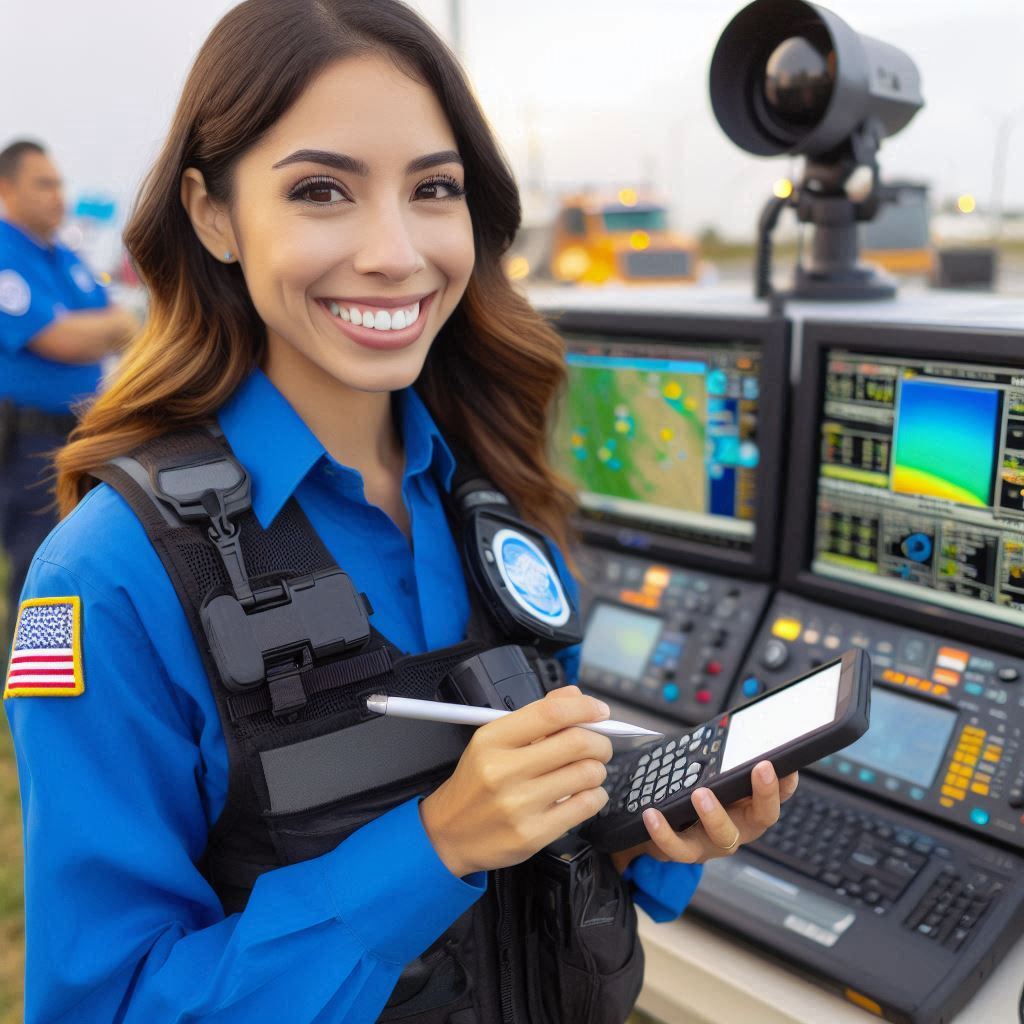Introduction
Emergency response involves quick and effective actions to mitigate the impact of disasters.
Meteorologists play a crucial role in predicting and responding to natural disasters.
Their expertise in weather patterns and atmospheric conditions enables them to provide valuable information that helps in emergency planning and response.
When natural disasters like hurricanes, tornadoes, or wildfires strike, meteorologists are at the forefront of monitoring and forecasting these events.
They use advanced technology and data analysis to track the movement and intensity of these disasters, providing early warnings to communities in harm’s way.
Meteorologists work closely with emergency management agencies, providing real-time updates and guidance during emergencies.
Their accurate predictions help in making informed decisions on evacuation orders, resource allocation, and disaster preparedness measures.
During extreme weather events, such as severe storms or heatwaves, meteorologists provide essential information to the public through various media channels.
Their timely alerts and safety tips can save lives and reduce property damage.
In essence, meteorologists are the unsung heroes behind the scenes of emergency response efforts.
Training and expertise of meteorologists
Meteorologists undergo extensive education and training to master their field.
Most meteorologists hold a bachelor’s degree in meteorology or atmospheric science.
Some pursue advanced degrees for specialized knowledge and research opportunities.
This educational background provides a solid foundation in physics, mathematics, and computer science.
Specialized Education and Training Required to Become a Meteorologist
Meteorologists learn about various atmospheric phenomena, including temperature, pressure, humidity, and wind patterns.
They study how these factors interact to create different weather systems.
Understanding these principles enables meteorologists to analyze complex weather data effectively.
They also gain hands-on experience with advanced technologies, such as radar and satellite imagery.
Knowledge and Skills That Meteorologists Possess in Understanding Weather Patterns and Forecasting
Meteorologists develop strong analytical skills to interpret data from various sources.
They use computer models to simulate weather patterns and predict future conditions.
By comparing different models, meteorologists can identify trends and improve the accuracy of their forecasts.
This expertise allows them to assess the severity and potential impacts of severe weather events.
In addition to technical skills, meteorologists need effective communication abilities.
They must convey complex information clearly and concisely to various audiences.
Meteorologists often work alongside emergency management teams, providing critical insights during emergencies.
Their expertise is vital for informing decision-makers and the public about potential risks.
Meteorologists also engage in continuous learning to stay current with advancements in their field.
They participate in workshops, conferences, and professional organizations to enhance their skills.
This commitment to ongoing education ensures that meteorologists are well-equipped to handle emerging challenges.
How This Expertise is Essential in Providing Accurate and Timely Information During Emergencies
During emergencies, the accuracy and timeliness of weather information can save lives.
Meteorologists provide essential data that informs evacuation orders, shelter openings, and disaster response strategies.
Their ability to forecast severe weather events helps communities prepare for potential impacts.
By analyzing real-time data, meteorologists can issue warnings and alerts, enabling timely responses.
Furthermore, meteorologists collaborate with other experts, such as climatologists and hydrologists, to gain a comprehensive understanding of weather events.
This interdisciplinary approach enhances their ability to provide accurate forecasts.
By integrating various data sources, meteorologists can paint a complete picture of the atmospheric conditions.
The training and expertise of meteorologists are crucial in emergency response.
Their specialized education equips them with the knowledge needed to understand complex weather patterns.
The skills they acquire during training enable them to forecast severe weather accurately.
In emergencies, meteorologists deliver timely and critical information, guiding communities in their response efforts.
Their role in emergency management highlights the importance of investing in meteorological education and training.
As severe weather events become more frequent, the contributions of meteorologists will continue to be essential in safeguarding lives and property.
Early Warning Systems and Disaster Preparedness
How Meteorologists Play a Crucial Role in Developing Early Warning Systems for Natural Disasters
Meteorologists play a crucial role in developing early warning systems for natural disasters.
They analyze weather patterns and data to predict severe events.
This information allows for timely alerts about hurricanes, tornadoes, and severe storms.
Meteorologists utilize advanced technologies, such as radar and satellite imagery, to monitor atmospheric conditions.
These early warning systems are essential for public safety.
They provide critical information about impending disasters, helping communities prepare.
Meteorologists continually update forecasts to reflect changing conditions.
This real-time data ensures that warnings remain accurate and relevant.
How Meteorologists Work with Emergency Management Agencies to Create Disaster Preparedness Plans
Meteorologists collaborate with emergency management agencies to create disaster preparedness plans.
They share their expertise to develop effective strategies for various scenarios.
These plans include evacuation routes, shelter locations, and communication protocols.
Working together, meteorologists and emergency managers ensure that communities are ready for potential disasters.
Emergency management agencies rely on meteorologists for accurate weather forecasts.
This information helps them assess risks and allocate resources effectively.
By understanding the potential impacts of severe weather, agencies can plan accordingly.
They can mobilize personnel, equipment, and supplies in advance.
Preparedness plans also involve public education initiatives.
Meteorologists engage with communities to teach them about weather safety.
They explain the importance of having emergency kits and communication plans.
This proactive approach empowers individuals to respond effectively during crises.
Importance of These Preparations in Saving Lives and Minimizing Damage During Emergencies
The importance of early warning systems cannot be overstated.
Timely alerts can save lives and minimize damage during emergencies.
For example, a hurricane warning allows residents to evacuate before the storm strikes.
Similarly, tornado warnings provide precious minutes for individuals to seek shelter.
Research shows that effective early warning systems significantly reduce fatalities.
Studies indicate that communities with well-implemented systems experience fewer casualties.
Preparedness plans enhance public resilience during natural disasters.
They equip individuals with the knowledge to make informed decisions.
Meteorologists also evaluate the effectiveness of early warning systems.
They analyze data from past events to identify areas for improvement.
This ongoing assessment helps refine forecasting techniques and communication strategies.
By learning from previous disasters, meteorologists can enhance future preparedness efforts.
Meteorologists play a vital role in developing early warning systems and disaster preparedness plans.
Their expertise informs critical decisions that protect communities from natural disasters.
By collaborating with emergency management agencies, they create effective strategies for various scenarios.
These preparations ultimately save lives and minimize damage during emergencies, reinforcing the importance of meteorological contributions to public safety.
Read: Interdisciplinary Research: Botany and Other Sciences
Monitoring and Tracking Severe Weather Events
Meteorologists employ various tools and technologies to monitor and track severe weather events.
How Meteorologists Use Various Tools and Technologies to Monitor and Track Severe Weather Events
They use radar systems to detect precipitation, wind speed, and storm rotation.
Doppler radar provides crucial information about storm structure and movement.
This data helps meteorologists identify severe thunderstorms and tornadoes in real time.
Satellite imagery is another essential tool for meteorologists.
Satellites capture images of cloud cover and atmospheric conditions across large areas.
Meteorologists analyze these images to track storm development and movement.
Satellite data also helps identify potential storm formation in the tropics.
Computer models play a vital role in forecasting weather patterns.
These models simulate atmospheric conditions based on current data and physical equations.
Meteorologists run various models to predict storm paths, intensity, and timing.
They compare results from different models to determine the most accurate forecast.
How Meteorologists Analyze and Interpret Data to Predict the Path, Intensity, and Timing of Storms
Meteorologists analyze and interpret data from multiple sources.
They integrate radar, satellite, and model data to create a comprehensive view of the weather.
This analysis helps them understand how storms evolve and interact with other weather systems.
Meteorologists can identify trends that indicate the potential for severe weather.
Real-time monitoring is critical for issuing timely warnings.
Meteorologists continuously track changing weather conditions and update forecasts accordingly.
When a severe storm threatens, they quickly issue alerts to the public and emergency responders.
These warnings provide vital information about expected impacts and recommended actions.
Significance of This Real-Time Monitoring in Issuing Timely Warnings to the Public and Emergency Responders
The significance of timely warnings cannot be overstated.
Accurate and prompt alerts can save lives and reduce property damage.
For instance, tornado warnings can give people precious minutes to seek shelter.
Similarly, severe thunderstorm warnings inform communities about potential hazards like hail and damaging winds.
Meteorologists also communicate with local emergency management agencies.
They provide insights into storm potential and assist in emergency response planning.
This collaboration ensures that communities are prepared for severe weather events.
Public education is another crucial aspect of meteorological work.
Meteorologists engage in outreach programs to inform communities about severe weather safety.
They share information on how to respond to warnings and prepare for emergencies.
This proactive approach empowers individuals to take appropriate actions during severe weather events.
Meteorologists utilize various tools and technologies to monitor and track severe weather events.
Radar, satellite imagery, and computer models provide essential data for forecasting.
Their ability to analyze and interpret this data is crucial for predicting storm paths and intensities.
Real-time monitoring enables meteorologists to issue timely warnings, significantly enhancing public safety.
Through education and collaboration, meteorologists play a vital role in preparing communities for severe weather challenges.
Read: Women in Botany: Celebrating Pioneers and Leaders

Communication and collaboration during emergencies
How Meteorologists Work Closely with Emergency Response Teams, Government Agencies, and Media Outlets
Meteorologists play a vital role in emergency response.
They work closely with emergency response teams, government agencies, and media outlets.
This collaboration ensures the public receives crucial information quickly and accurately.
Meteorologists share timely updates on weather conditions, forecasts, and warnings.
Meteorologists communicate weather warnings and safety tips to those at risk.
They convey critical information about severe weather events, such as hurricanes and tornadoes.
Clear communication helps individuals understand the urgency of the situation.
It allows them to take necessary precautions to protect themselves and their families.
Emergency response teams rely on meteorologists for accurate forecasts.
They use this information to make informed decisions about evacuations and resource allocation.
Meteorologists provide real-time updates, allowing teams to adapt their strategies as conditions change.
This dynamic approach enhances the overall effectiveness of emergency response efforts.
Role of Meteorologists in Communicating Weather Warnings, Evacuation Orders, and Safety Tips to Those at Risk
Collaboration with government agencies is essential for coordinated responses.
Meteorologists work with local, state, and federal agencies to develop emergency plans.
They help agencies prepare for potential disasters by providing accurate weather data.
This partnership ensures that resources are mobilized efficiently during emergencies.
Media outlets play a crucial role in disseminating information to the public.
Meteorologists partner with journalists to report on severe weather events.
They provide insights into the expected impacts and safety measures.
By working together, they can reach a broader audience with critical updates.
Effective communication is vital during emergencies.
Meteorologists must present complex weather data in understandable terms.
They strive to use clear language that resonates with the public.
Infographics, maps, and visuals enhance understanding and retention of important information.
Importance of Clear and Effective Communication in Ensuring Public Safety and Response Coordination
During emergencies, every second counts.
Clear communication can save lives and reduce injuries.
For instance, timely evacuation orders can prevent casualties during a hurricane.
Similarly, immediate weather warnings can prompt individuals to seek shelter from tornadoes.
Meteorologists also educate the public on safety tips.
They inform communities about creating emergency plans and preparedness kits.
This knowledge empowers individuals to respond proactively during disasters.
The more informed the public, the better equipped they are to handle emergencies.
Training and simulations enhance communication efforts.
Meteorologists practice delivering emergency messages under various scenarios.
These drills help them refine their messaging strategies.
They learn to adapt their communication styles based on the audience.
Meteorologists play a crucial role in communication and collaboration during emergencies.
They work closely with emergency response teams, government agencies, and media outlets.
Their clear and effective communication ensures public safety and coordinated responses.
By sharing timely information, meteorologists help save lives during critical situations.
Read: How Climate Change Is Impacting Plant Research
Explore Further: Funding and Grants for Anthropology Research
Post-disaster analysis and improvements
How Meteorologists Conduct Post-Disaster Analysis
Meteorologists conduct post-disaster analysis to evaluate their forecasts’ accuracy.
This process helps them understand what went well and what needs improvement.
They gather data from various sources, including satellite imagery, radar data, and on-ground observations.
This information allows meteorologists to assess the effectiveness of their predictions.
After a disaster, meteorologists review their forecasting models.
They compare predicted outcomes with actual results.
This comparison helps them identify gaps in their models.
By understanding these discrepancies, meteorologists can refine their forecasting techniques.
This continuous evaluation enhances the reliability of future predictions.
Transform Your Career Today
Unlock a personalized career strategy that drives real results. Get tailored advice and a roadmap designed just for you.
Start NowHow Meteorologists Use This Information to Make Improvements
Meteorologists also analyze emergency response efforts after a disaster.
They examine how well agencies executed their plans.
This analysis includes evaluating evacuation orders, resource allocation, and communication strategies.
By assessing these factors, meteorologists provide valuable insights for future preparedness.
This information helps emergency management agencies improve their response protocols.
Meteorologists use the findings from post-disaster analysis to make improvements.
They update forecasting models based on lessons learned.
This can involve incorporating new data sources or enhancing algorithms.
Meteorologists also work to improve warning systems.
They aim to ensure that alerts reach the public in a timely manner.
The feedback loop between forecasting and response is crucial.
Meteorologists collaborate with emergency management teams to implement changes.
They share insights about how to better communicate warnings and safety information.
This collaboration fosters a more effective emergency response framework.
Continuous Learning and Adaptation Process That Meteorologists Undergo to Enhance Their Contributions
Meteorologists engage in continuous learning and adaptation.
They participate in training sessions and workshops to enhance their skills.
This ongoing education ensures they stay updated on the latest advancements in meteorology.
It also enables them to apply new techniques in their work.
Technological advancements also play a role in improving meteorological practices.
New tools allow meteorologists to analyze data more effectively.
This includes machine learning algorithms that can identify patterns in weather data.
These tools enhance the accuracy of forecasting models.
Meteorologists also benefit from collaborative efforts with other scientists.
They share research findings and best practices within the scientific community.
This collaboration fosters innovation and drives improvements in meteorological science.
Meteorologists conduct thorough post-disaster analyses to enhance their forecasting and response efforts.
They evaluate their models and analyze emergency responses.
This information drives improvements in forecasting techniques, warning systems, and emergency protocols.
Through continuous learning and adaptation, meteorologists significantly enhance their contributions to emergency response efforts.
Their work ultimately helps save lives and reduce damage during disasters.
Read: Exploring the Different Branches of Geology
Gain More Insights: Essential Lab Equipment for Toxicology Research
You Might Also Like: Balancing Research and Data Science Projects
Explore Further: Key Research Methods Used by Modern Ecologists
Public Trust and Reliance on Meteorologists
Relationship Between Meteorologists and the Public in Terms of Trust and Credibility During Emergency Situations
Meteorologists play a crucial role in informing the public during emergencies.
Their forecasts directly impact people’s safety and preparedness.
Building trust is essential for effective communication.
When the public trusts meteorologists, they are more likely to heed warnings and take necessary actions.
Credibility stems from consistent, accurate forecasting and transparent communication.
Meteorologists must provide clear and concise information to maintain this trust.
Impact of Accurate Forecasting and Timely Warnings on Public Perception and Response to Severe Weather Events
Accurate forecasting significantly affects public perception of meteorologists.
When forecasts are precise, the public views meteorologists as reliable sources.
Timely warnings enable communities to prepare for severe weather events.
For example, accurate predictions of hurricanes allow residents to evacuate or secure their homes.
Conversely, inaccurate forecasts can lead to skepticism and distrust.
If people feel misled, they may ignore future warnings.
The media often amplifies meteorological information.
Therefore, effective communication strategies are vital.
Meteorologists must collaborate with media outlets to ensure messages reach the public.
Consistent messaging across platforms enhances credibility and encourages appropriate responses.
Public workshops and outreach programs can also help build relationships.
Engaging with communities fosters a sense of reliability and accountability.
Importance of Building and Maintaining Public Trust in Meteorologists
Maintaining public trust requires ongoing effort from meteorologists.
They must continuously provide accurate forecasts and timely information.
Regular updates during severe weather events keep the public informed and engaged.
Using social media platforms can also enhance communication.
Meteorologists can share real-time updates and safety tips through these channels.
Public education is another critical component.
Meteorologists should help communities understand weather patterns and forecasting processes.
This knowledge empowers the public to interpret forecasts better.
When people understand the science behind weather predictions, they are more likely to trust the information provided.
Moreover, meteorologists should acknowledge uncertainties in forecasting.
Communicating the potential for variability enhances credibility.
People appreciate honesty and transparency in predictions.
They are more likely to trust meteorologists who explain the complexities of weather forecasting.
The relationship between meteorologists and the public hinges on trust and credibility.
Accurate forecasting and timely warnings significantly impact public perception.
Building and maintaining public trust is essential for effective emergency preparedness and response.
By fostering strong relationships and transparent communication, meteorologists can ensure that the public remains informed and responsive during emergencies.
This trust ultimately saves lives and minimizes damage during severe weather events.
Conclusion
Meteorologists play a critical role in emergency response efforts.
They predict, monitor, and communicate vital information during natural disasters.
Their expertise helps save lives and reduce damage.
Accurate forecasts enable communities to prepare for severe weather effectively.
Meteorologists use advanced technology to monitor weather patterns continuously.
They analyze data to provide timely alerts and warnings.
Clear communication is essential during emergencies.
It ensures that the public understands risks and necessary actions.
Moreover, meteorologists collaborate with emergency management teams and local authorities.
This teamwork enhances disaster preparedness and response.
They work diligently to develop early warning systems for various disasters.
Communities must recognize the essential contributions of meteorologists.
Continued support for their work will enhance public safety.
Investing in meteorological research and technology improves forecasting and response capabilities.
By acknowledging their efforts, we can strengthen the bond between meteorologists and the public.
Together, we can safeguard communities from severe weather impacts.
Let us advocate for ongoing recognition and support for meteorologists in their vital mission.
Their work is crucial for protecting lives and property during natural disasters.
[E-Books for Sale]
The Big Book of 500 High-Paying Jobs in America: Unlock Your Earning Potential
$19.99 • 500 High-Paying Jobs • 330 pages
Explore 500 high-paying jobs in America and learn how to boost your career, earn more, and achieve success!
See All 500 High-Paying Jobs of this E-Book
1001 Professions Without a Degree: High-Paying American Jobs You Can Start Now
$19.99 • 1001 Professions Without a Degree • 174 pages
Discover 1001 high-paying jobs without a degree! Unlock career tips, skills, and success strategies for just $19.99!




